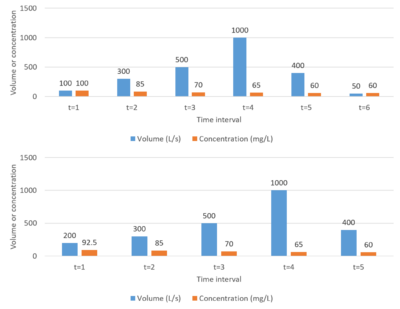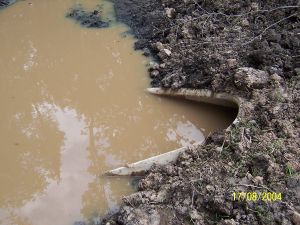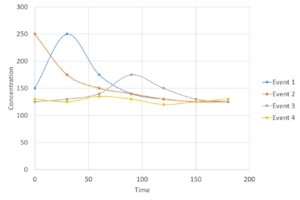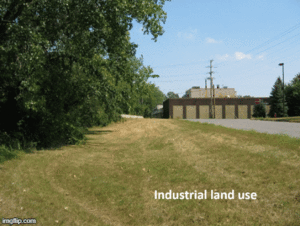
Difference between revisions of "Stormwater pollutant concentrations and event mean concentrations"
m (→Land use) |
m (→Land use) |
||
| Line 101: | Line 101: | ||
*Although the potential for nutrient and bacteria loads is greater in lower density residential areas, the lower amount of directly connected impervious surface typically results in lower emcs for lower density residential land use. | *Although the potential for nutrient and bacteria loads is greater in lower density residential areas, the lower amount of directly connected impervious surface typically results in lower emcs for lower density residential land use. | ||
*Pollutant concentrations in open, forested, and park areas are lower, primarily due to reduced impervious surface. | *Pollutant concentrations in open, forested, and park areas are lower, primarily due to reduced impervious surface. | ||
| − | *There is limited information on many of the newer chemicals, such as commercial-consumer compounds, veterinary and human pharmaceuticals, lifestyle and personal care compounds, and others. These chemicals, generically labeled as contaminants of emerging concern (CEC), have variable sources, including industry, sediment, and atmospheric deposition. For more information, see [https://www.researchgate.net/profile/Richard_Kiesling/publication/326916617_Contaminants_of_emerging_concern_in_urban_stormwater_Spatiotemporal_patterns_and_removal_by_iron-enhanced_sand_filters_IESFs/links/5b85452192851c1e12372f0f/Contaminants-of-emerging-concern-in-urban-stormwater-Spatiotemporal-patterns-and-removal-by-iron-enhanced-sand-filters-IESFs.pdf Fairbairn et al.] (2018), [https:// | + | *There is limited information on many of the newer chemicals, such as commercial-consumer compounds, veterinary and human pharmaceuticals, lifestyle and personal care compounds, and others. These chemicals, generically labeled as contaminants of emerging concern (CEC), have variable sources, including industry, sediment, and atmospheric deposition. For more information, see [https://www.researchgate.net/profile/Richard_Kiesling/publication/326916617_Contaminants_of_emerging_concern_in_urban_stormwater_Spatiotemporal_patterns_and_removal_by_iron-enhanced_sand_filters_IESFs/links/5b85452192851c1e12372f0f/Contaminants-of-emerging-concern-in-urban-stormwater-Spatiotemporal-patterns-and-removal-by-iron-enhanced-sand-filters-IESFs.pdf Fairbairn et al.] (2018), [https://setac.onlinelibrary.wiley.com/doi/abs/10.1002/ieam.1702 Maruya] (2013), [https://pubs.acs.org/doi/10.1021/acs.est.9b02867 Masoner et al.] (2019), and [https://www.sciencedirect.com/science/article/pii/S0048969718336465 Kiesling et al.] (2019). |
{{:Curve numbers for antecedent mositure condition 2}} | {{:Curve numbers for antecedent mositure condition 2}} | ||
Revision as of 12:18, 25 May 2022
Because of the expense and difficulty of monitoring stormwater runoff, we often rely on published information to estimate pollutant loading associated with runoff. Models or other tools are often used to predict pollutant loading. These models and tools require information on the pollutant concentration in runoff. For example, the Simple Method, which is commonly used to estimate pollutant loading, utilizes the following equation
\(L = 0.227 P P_j R_v C A\)
where
- L = Load of a pollutant in pounds per year;
- P = Rainfall depth per year (inches);
- Pj = Fraction of rainfall events that produce runoff;
- Rv = Runoff coefficient, which expresses the fraction of rainfall which is converted into runoff. Rv = 0.05 + 0.009(I);
- I = Site imperviousness (i.e., I = 75 if site is 75% impervious);
- C = Flow-weighted mean concentration of the pollutant in urban runoff (mg/l); and
- A = Area of the development site (acres).
This page provides a discussion of pollutant concentrations in stormwater runoff, including a review of literature and links recommended values to use.
Contents
Factors affecting actual and measured storm concentrations
The actual concentration of a pollutant in stormwater runoff varies with several factors, including but not limited to
- land use,
- time between runoff events,
- duration and intensity of runoff,
- characteristics of the pollutant,
- season,
- extent of exposed soils, such as with construction sites, and
- extent of connected impervious surfaces.
In addition, the measured concentration varies with factors related to measurement, including but not limited to
- type of sampling equipment and sample collection,
- location of sampling,
- frequency of sampling,
- laboratory analysis, and
- data analysis.
This variability presents challenges in estimating pollutant loading, but having accurate estimates of pollutant concentrations is necessary to accurately calculate pollutant loading and reductions in loading associated with implementation of stormwater practices and to accurately select and design appropriate practices to treat runoff.
Event mean concentrations
In the absence of monitoring data for a specific study or location, we often use event mean concentrations (emc). The emc represents the average pollutant concentration for a given stormwater event, expressed in units of mass per volume (e.g., mg/L). Given the number of factors affecting pollutant concentration, determining an appropriate emc is challenging.
Despite challenges in accurately determining emcs, they are widely used in stormwater applications. Emcs are used in many stormwater water quality models and calculations of pollutant loading. They are therefore fundamental to understanding pollutant loads and how to address reducing pollutant loads in stormwater runoff.
Calculating emcs
Emcs should represent the flow-weighted mean concentration of a given pollutant parameter during storm events. The simplest way to calculate and emc is therefore to divide the total mass of a pollutant by the total runoff volume. Emcs can also be calculated as the sum, over multiple discrete time intervals within an event, of volume times the concentration for the time interval, divided by the total volume for the event
\( emc = (∫^t_0 C_tQ_td_t) / (∫^t_0 Q_td_t) ≅ (Σ C_tQ_tΔt) / (ΣQ_tΔt) \)
where Ct and Qt are the concentration and flow volume over a discrete time interval dt (Δt).
Erickson et al. provide detailed discussion and examples for calculating pollutant loading from stormwater runoff. The emc calculated for a specific event is a function of the sampling method. Erickson et al. discuss the following methods for sampling.

- Flow-weighted discrete samples: "When samples are collected based on a user-specified constant incremental volume of discharge (e.g., every 1000, 2000, or 5000 gallons) that passes the sampler, the samples are defined as flow-weighted. Each flow-weighted sample is assumed to represent the average pollutant concentration for the entire incremental volume of water to which it corresponds. Each discrete sample is stored in an individual container, and the contents of each container are analyzed separately."
- Flow-weighted composite samples: "Flow-weighted composite samples are collected every time a user-specified constant volume of flow passes the sampler and all samples are stored in a single container. To determine pollutant concentration, an aliquot is collected from the composite sample, and the concentration is assumed to represent that of the entire composite sample."
- Time-weighted discrete samples: "Time-weighted discrete samples are collected at a user-specified, constant time interval (e.g., 30 minutes), and each sample is stored in a separate container and analyzed separately. Because the magnitude of the discharge during a natural storm event varies over time, each time-weighted sample does not represent a constant volume of discharge."
- Time-weighted composite samples: "Time-weighted composite samples are collected at equal time increments, and all samples are stored in a single container. ... Time-weighted composite sampling is not recommended."
- Discrete grab samples: "A grab sample is a single sample collected at one location over a relatively short time period, typically sampling the entire cross-section of water. Discharge must be accurately and continuously measured and the time of each grab sample must be recorded to assess pollutant removal performance. Discrete samples are stored in individual containers, and the contents of each container are analyzed separately."
- Composite grab samples: "Composite grab samples are typically collected at variable time and volume increments and stored in a single sample storage container. Composite grab sampling is not recommended."
The sampling method affects the resulting calculation of emc. For example, in the adjacent image, emcs were calculated for the same runoff event. In the top portion of the image, sampling occurred every 30 minutes and the overall emc is 69.1 mg/L. In the lower portion of the image, the first two time intervals were combined and Q and C averaged over the 60 minute time interval, while the remaining time intervals were 30 minutes each. The overall emc is 76.0 mg/L. The difference is a result of a bias toward higher concentrations in the early portion of the runoff event for the lower graph. This tendency toward higher pollutant concentrations in the early part of a runoff event is called the first flush.
Washington State developed standard operating procedures for measuring pollutant loads, including emcs. They include procedures for addressing seasonality.
Factors affecting emcs
Many factors affect the emc. The most important factors and how to address them are dicussed below.
| First flush is a phenomenon in which pollutant concentrations in stormwater runoff are greater in the early portion of a runoff event. First flush is common for relatively uniform land use settings, for winter and early spring runoff events, and for runoff events during fall leaf-drop. During dry periods between runoff events, pollutants build-up on impermeable surfaces. For Type 2 rain distribution, initial rain intensity is low and increases through a storm before decreasing near the end of the storm. The initial runoff is therefore highly concentrated with pollutants that have accumulated on impermeable surfaces. As runoff volume increases during an event and pollutants become more resistant to being washed off, concentrations decrease and typically reach steady state. First flush is not universally applicable to stormwater runoff, however. For example, if higher pollutant buildup on impermeable surfaces occurs in upper portions of a watershed, as might occur in an area with variable land uses, the peak concentration may be delayed as those higher pollutant loads take time to reach a receiving point. Similarly, some pollutants may be resistant to transport in early stages of an event. In other situations, concentrations in runoff may be uniform throughout an event, particularly if rainfall intensities are uniform and pollutants are soluble (e.g. chloride). |
Land use
Because of the variability in emcs across different land uses, it is beneficial to consider different land uses when calculating pollutant loads. Compositing emcs across land uses is generally not recommended.
Some generalizations about pollutant loading as a function of land use include the following.
- Commercial, industrial, and transportation land use typically have higher percentages of impervious and directly connected impervious surface, as shown in the accompanying table summarizing curve numbers for different land uses. This results in more efficient delivery of pollutants and runoff compared to other land uses. Consequently, we expect higher emcs from these land uses for smaller runoff events and when pollutant buildup on impermeable surfaces is greater, and lower emcs for larger runoff events with greater rainfall intensities as a result of dilution.
- Nutrient (phosphorus, nitrogen) concentrations are greater in residential areas and other land uses that contribute significant amounts of organic material to impermeable surfaces. Dissolved fractions also comprise a greater percent of the total load for these pollutants when the source of the nutrient is organic material.
- Concentrations of metals increase as road density and traffic volume increase.
- Concentrations of petroleum-related compounds and polycyclic aromatic hydrocarbons (PAHs) increase as road density and traffic volume increase.
- Concentrations of total suspended solids (TSS) may be similar across different land uses, but the characteristics of the TSS varies. Organic fractions make up a larger percent of TSS in residential areas and other land uses where there are sources of organic material to impermeable surfaces, while inorganic fractions (e.g. sand, silt) comprise the majority of TSS in settings with low inputs of organic material.
- Bacteria concentrations are typically greater in residential areas due to greater inputs from domestic animals (e.g. dogs), birds, and other animals. Studies also suggest irrigated lawns and leaves/organic material on impermeable surfaces contribute to bacteria loads.
- In cold climates where deicers are applied, chloride concentrations are a function of deicer application rates. Chloride concentrations are therefore highly variable in areas where deicers are applied. Also note that within a land use receiving high inputs of chloride-deicers, chloride emcs vary with season.
- Oxygen demand is typically related to the amount of organic carbon in runoff. Thus, land uses with greater inputs of organic material (e.g. residential) will have greater oxygen demand.
- Concentrations of several organic chemicals, such as pesticides and chlorinated compounds, varies. Factors affecting concentrations include industrial sources, presence of contaminated sites, historic use of these materials, and atmospheric deposition.
- Although the potential for nutrient and bacteria loads is greater in lower density residential areas, the lower amount of directly connected impervious surface typically results in lower emcs for lower density residential land use.
- Pollutant concentrations in open, forested, and park areas are lower, primarily due to reduced impervious surface.
- There is limited information on many of the newer chemicals, such as commercial-consumer compounds, veterinary and human pharmaceuticals, lifestyle and personal care compounds, and others. These chemicals, generically labeled as contaminants of emerging concern (CEC), have variable sources, including industry, sediment, and atmospheric deposition. For more information, see Fairbairn et al. (2018), Maruya (2013), Masoner et al. (2019), and Kiesling et al. (2019).
Curve numbers for antecedent moisture condition II (Source USDA-NRCS).
Link to this table
| A | B | C | D | |
|---|---|---|---|---|
| Meadow - good condition | 30 | 58 | 72 | 78 |
| Forest | ||||
| Poor | 45 | 66 | 77 | 83 |
| Fair | 36 | 60 | 73 | 79 |
| Good | 30 | 55 | 70 | 77 |
| Open space | ||||
| Poor | 68 | 79 | 86 | 89 |
| Fair | 49 | 69 | 79 | 84 |
| Good | 39 | 61 | 74 | 80 |
| Commercial 85% impervious | 89 | 92 | 94 | 95 |
| Industrial 72% impervious | 81 | 88 | 91 | 93 |
| Residential | ||||
| 1/8 acre lots (65% impervious) | 77 | 85 | 90 | 92 |
| 1/4 acre lots (38% impervious) | 61 | 75 | 83 | 87 |
| 1/2 acre lots (25% impervious) | 54 | 70 | 80 | 85 |
| 1 acre lots (20% impervious) | 51 | 68 | 79 | 84 |
| Impervious areas | 98 | 98 | 98 | 98 |
| Roads (including right of way) | ||||
| Paved | 83 | 89 | 92 | 93 |
| Gravel | 76 | 85 | 89 | 91 |
| Dirt | 72 | 82 | 87 | 89 |
| Row crops | ||||
| Straight row - good | 67 | 78 | 85 | 89 |
| Contoured row - good | 65 | 75 | 82 | 86 |
| Pasture - good | 39 | 61 | 74 | 80 |
| Open water | 99 | 99 | 99 | 99 |
Effects of season
For most pollutants, there are few studies of seasonal effects on emcs. The most extensive study is that of Brezonik and Stadelmann (2002). The limited information suggests the following.
- Ranges (variability) of emcs are largest in spring
- Median concentrations of many chemicals is higher in the initial spring flush
- For individual pollutants, the following are observed.
- TSS concentrations are highest in winter and decrease throughout the year
- Total phosphorus concentrations are highest in winter and fall
- Dissolved and soluble reactive phosphorus concentrations are highest in winter
- Chemical oxygen demand is highest in winter
- Inorganic nitrogen concentrations are highest in winter
- Organic nitrogen concentrations are highest in spring
- Bacteria concentrations are highest in summer
- Chloride concentrations are highest in winter
Effects of rainfall characteristics
Several studies indicate rainfall characteristics are very important when assessing pollutant loads for discrete events or discrete time periods. When assessing loads on an annual basis, these factors are less important.
Rainfall factors affecting emcs include the following.
- Duration between rain events. As the duration between events increases, pollutants build up on impervious surfaces, resulting in increased pollutant concentrations when runoff occurs. The first flush effect becomes more pronounced as the interval between runoff events increases.
- Short duration, higher intensity rain events result in higher concentrations of solids, pollutants associated with solids, oil, grease, and other relatively soluble organic pollutants
- Longer duration, lower intensity rain events result in higher concentrations of dissolved nutrients (phosphorus and nitrogen), as these typically result from leaching from organic material
- Greater runoff volumes result in lower emcs over an entire runoff event, as a result of dilution
Effects of connected impervious surface and watershed characteristics
First flush effects are greatest in small watersheds with a high degree of connected impervious surfaces.
Event mean concentrations for different pollutants
Tabled values of recommended emcs are found at the following page - Stormwater event mean concentrations and pollutant loading/export rates for different land uses. For some pollutants, we developed individual pages with a literature review and discussion.
- Event mean concentrations of total and dissolved phosphorus in stormwater runoff
- Event mean concentrations of total suspended solids in stormwater runoff
References
- Acharya, A., and T. Piechota. 2010. Characterization of First Flush Phenomenon in an Urban Stormwater Runoff: A Case Study of Flamingo Tropicana Watershed in Las Vegas Valley. World Environmental and Water Resources Congress 2010: Challenges of Change. American Society of Civil Engineers. p 3365-3375. 10.1061/41114(371)347.
- Baldys III, S., T.H. Raines, B.L. Mansfield, and J.T. Sandlin. 1998. Urban Stormwater Quality, Event-Mean Concentrations, and Estimates of Stormwater Pollutant Loads, Dallas-Fort Worth Area, Texas, 1992–93. U.S. Geological Survey Water-Resources Investigations Report 98–4158.
- Bannerman, Roger T., Andrew D. Legg, and Steven R. Greb. 1996. Quality Of Wisconsin Stormwater, 1989-94. U.S. Geological Survey. Open-File Report 96-458.
- Bannerman, R.T., D. W.Owens,R. B.Dodds, and N. J. Hornewer. 1993. Sources of Pollution in Wisconsin Stormwater. Wac Sci tech 28:3-5. pp. 241-259.
- Bartley, Rebecca, and William Speirs. 2010. A review of sediment and nutrient concentration data from Australia for use in catchment water quality models. eWater Cooperative Research Centre Technical Report.
- Brezonik PL, Stadelmann TH.. 2002. Analysis and predictive models of stormwater runoff volumes, loads, and pollutant concentrations from watersheds in the Twin Cities metropolitan area, Minnesota, USA. Water Res. Apr;36(7):1743-57. DOI: 10.1016/s0043-1354(01)00375-x
- Erickson, A.J., P.T. Weiss, J.S. Gulliver, R.M. Hozalski. Analysis of individual storm events, Stormwater Treatment: Assessment and Maintenance. Accessed December 31, 2019.
- Gong, Y., X. Liang, X. Li, J. Li, X. Fang, and R. Song. 2016. Influence of Rainfall Characteristics on Total Suspended Solids in Urban Runoff: A Case Study in Beijing, China. Water 2016, 8(7), 278; https://doi.org/10.3390/w8070278
- Hallberg, M., G. Renman. 2008. Suspended Solids Concentration in Highway Runoff during Summer Conditions. Pol. J. Environ. Stud. 17(2):237–241.
- Jung, Jae-Woon, Ha-Na Park, Kwang-Sik Yoon, Dong-Ho Choi, Byung-Jin Lim. 2013. Event mean concentrations (EMCs) and first flush characteristics of runoff from a public park in Korea. Journal of the Korean Society for Applied Biological Chemistry. October 2013, Volume 56, Issue 5, pp 597–604.
- Kim, Lee-Hyung. 2003. Determination of event mean concentrations and first flush criteria in urban runoff. Environ. Eng. Res. 8:4:163-176.
- Li D, Wan J, Ma Y, Wang Y, Huang M, Chen Y. 2015. Stormwater Runoff Pollutant Loading Distributions and Their Correlation with Rainfall and Catchment Characteristics in a Rapidly Industrialized City. PLoS ONE 10(3): e0118776. doi:10.1371/journal.pone.0118776
- Maniquiz, Marla C. , Soyoung Lee, Lee-Hyung Kim. 2010. Multiple linear regression models of urban runoff pollutant load and event mean concentration considering rainfall variables. Jour Environ. Sci. 22:6:946-852.
- Maniquiz, Marla C., Jiyeon Choi, Soyoung Lee, Hye Jin Cho, Lee-Hyung Kim. 2010. Appropriate Methods in Determining the Event Mean Concentration and Pollutant Removal Efficiency of a Best Management Practice. Environmental Engineering Research. 15:215-223.
- Pan X, Jones KD. 2012. Seasonal variation of fecal indicator bacteria in storm events within the US stormwater database. Water Sci Technol. 65(6):1076-80. doi: 10.2166/wst.2012.946.
- Schiff, Kenneth C., and Liesl L. Tiefenthaler. 2011. Seasonal flushing of pollutant concentrations and loads in urban stormwater. Jour. Amer. Water Works Assoc. 47:1:136-143
- Schiff, Kenneth C., and Liesl L. Tiefenthaler. 2016. Effects of Rainfall Intensity and Duration on the First Flush from Parking Lots. Water. 8(8), 320. https://doi.org/10.3390/w8080320
- Stein, Eric D., Liesl L. Tiefenthaler and Kenneth C. Schiff. 2008. Comparison of stormwater pollutant loading by land use type. Southern California Coastal Water Research Project, AR08-015-027.
- Stein, Eric D., Liesl L. Tiefenthaler and Kenneth C. Schiff. 2007. SOURCES, PATTERNS AND MECHANISMS OF STORM WATER POLLUTANT LOADING FROM WATERSHEDS AND LAND USES OF THE GREATER LOS ANGELES AREA, CALIFORNIA, USA. Technical Report 510.
- Stenstrom, M.K., and M. Kayhanian. 2005. First Flush Phenomenon Characterization. Prepared for: California Department of Transportation. 81 p.
- Tiefenthaler, L.L., K. C. Schiff, and M. K. Leecaster. 1997. Temporal variability patterns of stormwater concentrations in urban stormwater runoff.
- University of Wisconsin at Milwaukee. Phosphorus Speciation and Loads in Stormwater and CSOs of the MMSD Service Area (2000 – 2008) Final Report: February, 2011
- Wang, Shumin, Qiang Hea, Hainan Aia, Zhentao Wanga, and Qianqian Zhang. 2013. Pollutant concentrations and pollution loads in stormwater runoff from different land uses in Chongqing. Journal of Environmental Sciences. Volume 25, Issue 3, Pages 502-510. https://doi.org/10.1016/S1001-0742(11)61032-2.
- Washington District Department of the Environment. 2014. Selection of Event Mean Concentrations (EMCs).
- Yang, Yun-Ya, and Gurpal S. Toor. 2018. runoff driven phosphorus transport in an urban residential catchment: Implications for protecting water quality in urban watersheds. Scientific Reports. 8:1-10
Related pages
- Stormwater event mean concentrations and pollutant loading/export rates for different land uses
- Total Suspended Solids (TSS) in stormwater
- Event mean concentrations of total and dissolved phosphorus in stormwater runoff
- Event mean concentrations of total suspended solids in stormwater runoff
- Bacteria in stormwater


